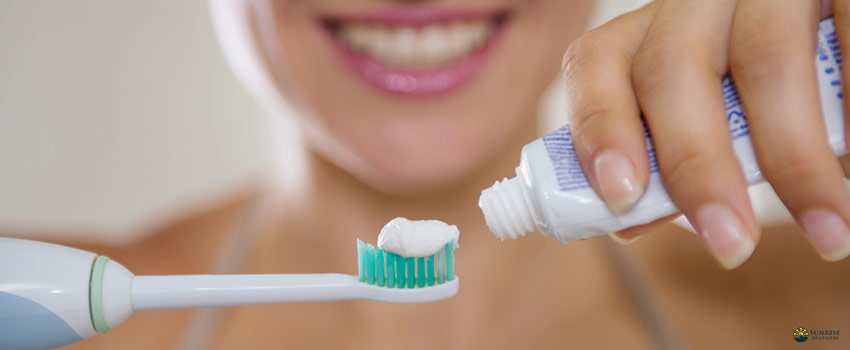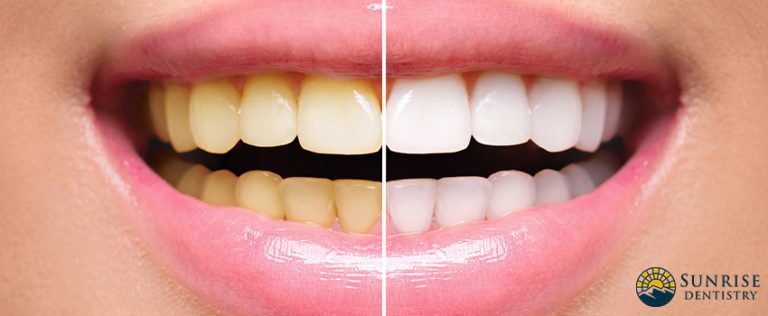How does one choose toothpaste?
The many varieties and brands of toothpaste make it confusing and overwhelming to choose one. We often hear “four out of five dentists agree” or “nine out of ten dentists agree” about toothpaste in ads. Most brands on the toothpaste aisle also put these in their advertisements, making it more difficult to choose. If all of them are good, then it wouldn’t really matter which one we choose, right?
Toothpaste is a relatively simple product with simple goals: keeping your breath fresh, preventing diseases, and keeping the mouth clean. Choosing one shouldn’t be difficult. Always remember what you’re using it for, and check its ingredients. You might find that not all toothpaste ingredients are good for our teeth; some may even harm our overall health.
It’s time to go beyond packaging. Learn more about toothpaste ingredients with Sunrise Dentistry.
The Basics
So, what is toothpaste made of? The oral health aisle in your grocery may be jam-packed with row upon row of different toothpaste brands, but they all share these basic ingredients:
1. Abrasives
Manufacturers add silicates, calcium carbonate, and other abrasive materials to toothpaste to remove food remnants and stains from your teeth. They are essential toothpaste ingredients, but they are considered “inactive” because they don’t decrease your risk for gum diseases and cavities.
Romans and Ancient Egyptians added crushed oyster shells, eggshells, and other abrasives to their toothpaste. Today’s toothpaste abrasives are more hygienic and gentle. Manufacturers now use calcium carbonate, dehydrated silica jelly, and hydrated aluminum oxides in their toothpastes. However, they should be used with caution. Avoid pressing your toothbrush too hard against your teeth; otherwise, you might damage your enamel and irritate your gums.
2. Detergents
Detergents make toothpaste foamy and soft, helping cover your teeth with active ingredients. Sodium lauryl sulfate (SLS) is the most common detergent manufacturers use. However, it’s an ingredient to avoid because it has caused adverse effects. Good thing there are now toothpastes with alternative detergents like sodium cocoyl glutamate, glycyrrhizin, and lauryl glucoside.
3. Flavoring
Let’s face it, detergents and abrasives don’t taste good. Manufacturers add flavoring like saccharin and sorbitol to their toothpaste to help make it more palatable.
They may be sweet, but they are not sugars that can cause tooth decay. The American Dental Association may give their Seal of Approval to toothpastes with these sweeteners, but not those that use sugar.
4. Humectants
Sorbitol, glycol, and glycerol are some examples of toothpaste humectants. They prevent toothpaste from drying out by trapping water, allowing it to smoothly come out of the tube with a creamy consistency.
The Good
Some of the best ingredients you’ll find in toothpaste are:
Hydrogen Peroxide
Some kinds of toothpaste have hydrogen peroxide because it reduces stains. A 2020 study that compared toothpaste with different levels of hydrogen peroxide showed that the higher levels of hydrogen peroxide, the more stains it reduces. However, concentrations of hydrogen similar to those in bottles damage teeth enamel.
Don’t worry; toothpaste with hydrogen peroxide has them in low amounts.
Potassium Nitrate
Choose toothpaste with potassium nitrate if you have sensitive teeth. A study in 2012 found that toothpastes and mouthwashes with potassium nitrate significantly lower teeth sensitivity.
You’ll feel results when you constantly use these oral hygiene products for several weeks. However, potassium nitrate is not for everyone to use since its only benefit is to lessen teeth sensitivity.
Calcium Carbonate
Calcium carbonate is an effective abrasive for stain removal and teeth cleaning. It’s safe to use as long as you use it carefully; brushing too hard can damage your tooth. You may observe the stains disappearing in as little as a few days of using products with calcium carbonate.
A Japanese study in 2019 found that toothpastes with calcium carbonate removed more plaque than those without it. The study also shows calcium carbonate does not cause gum tissue damage.
Zinc Citrate
Zinc citrate is one of the most popular toothpaste ingredients to reduce plaque, a sticky film that covers the teeth containing bacteria. Plaque absorbs calcium from your saliva and turns into tartar.
A 2008 study examined the effects of toothpaste containing zinc citrate on adults’ oral health. After 14 days, the group using zinc citrate saw a 24%-52% decrease in bacteria than the control group.
The Bad
Not all toothpaste ingredients are suitable for your teeth. Some ingredients may be too abrasive, which can wear down enamel.
Some toothpaste ingredients to avoid are:
Activated Charcoal
This has been a favorite ingredient in recent years due to its supposed whitening properties. However, it’s one of many harmful ingredients in toothpaste that is abrasive and can damage enamel. There is also not enough clinical data to support the safety and efficacy claims made by toothpastes with activated charcoal.
Sodium Lauryl Sulfate
SLS in toothpaste causes it to foam. However, it’s not entirely safe. Some people have experienced mouth sores, redness, peeling, and swelling. It also worsens aphthous ulcers.
In a preliminary study conducted by the Department of Oral Surgery and Oral Medicine, patients used a paste with SLS for three months, resulting in significantly more ulcers following the trial. Patients without SLS in toothpaste saw a dramatic decrease in their ulcers.
Artificial Sweeteners
Artificial sweeteners are harmful ingredients in toothpaste with inconsistent and contradictory study results.
Saccharin is a petroleum-based sugar substitute used in soft drinks, lip balms, diet foods, and toothpaste. It has been linked to bladder cancer, brain tumors, and lymphoma in the past; however, there’s no conclusive evidence supporting these claims.
Aspartame has been shown to alter gut bacteria and raise blood glucose linked to insulin resistance.
Propylene Glycol
Propylene glycol is one of the chemicals in toothpaste manufacturers add to improve product shelf life, texture, and appearance. However, it can damage the central nervous system, liver, and heart. Individuals with kidney disease or liver disease have slower breakdown processes, resulting in more severe effects.
Parabens
Parabens are also toothpaste ingredients that improve shelf life in many cosmetics and toothpastes. They mimic estrogen, causing hormone dysfunction. They also cause breast cancer and are linked to reproductive and developmental issues in animals.
The Food and Drug Administration has limited information on parabens and is still evaluating their safety.
Triclosan
Triclosan is an ingredient you’ll find in an antibacterial toothpaste. It’s also a pesticide used as an antibacterial agent with the claim it fights plaque and gingivitis. Cancer, weak heart muscle function, endocrine problems, and bone deformation are just a few health concerns linked with triclosan.
Seek Advice From Sunrise Dentistry
Look for the ADA Seal of Approval on your toothpaste as a rule of thumb.
If you still haven’t found the right toothpaste, Sunrise Dentistry can help. Our dentists in Durango, CO, can help you choose the best toothpaste for your needs or give you recommendations. We also offer various teeth whitening and oral care services to help you achieve your oral health goals. Call us for any questions and set an appointment





